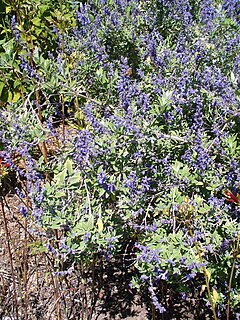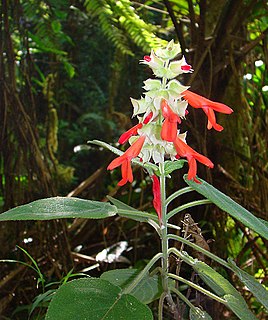Mimosa loxensis is a species of plant in the family Fabaceae. It is found only in Ecuador. Its natural habitat is subtropical or tropical dry shrubland.

The black-backed thornbill is a species of hummingbird in the family Trochilidae. It is found in the Sierra Nevada de Santa Marta. The species is currently endangered due to threats such as logging and forest fires.
Byttneria loxensis is a species of flowering plant in the family Malvaceae. It is found only in Ecuador. Its natural habitat is subtropical or tropical dry shrubland.
Guevaria loxensis is a species of flowering plant in the family Asteraceae. It is found only in Ecuador. Its natural habitat is subtropical or tropical moist montane forests. It is threatened by habitat loss.
Salvia austromelissodora is a species of flowering plant in the family Lamiaceae that is native to Ecuador. Its natural habitat is subtropical or tropical moist montane forests.
Salvia curticalyx is a species of flowering plant in the family Lamiaceae that is native to Ecuador. Its natural habitat is subtropical or tropical moist montane forests.
Salvia ecuadorensis is a species of flowering plant in the family Lamiaceae that is native to Ecuador. Its natural habitat is subtropical or tropical moist montane forests.

Salvia flocculosa is a species of flowering plant in the family Lamiaceae that is native to Ecuador. Its natural habitat is subtropical or tropical moist montane forests.
Salvia humboldtiana is a species of flowering plant in the family Lamiaceae that is endemic to Ecuador. Its natural habitat is subtropical or tropical dry valley shrubland.

Salvia leucocephala is a species of flowering plant in the family Lamiaceae that is native to Ecuador. Its natural habitat is subtropical or tropical dry shrubland.
Salvia peregrina is a species of flowering plant in the family Lamiaceae that is native to Ecuador. Its natural habitat is subtropical or tropical moist mountains.
Salvia quitensis is a species of flowering plant in the family Lamiaceae that is native to Ecuador. Its natural habitats are subtropical or tropical moist montane forests and subtropical or tropical high-altitude shrubland.
Salvia trachyphylla is a species of flowering plant in the family Lamiaceae that is native to Ecuador. Its natural habitats are subtropical or tropical moist montane forests and subtropical or tropical high-altitude shrubland.
Salvia unguella is a species of flowering plant in the family Lamiaceae that is native to Ecuador. Its natural habitat is subtropical or tropical moist montane forests.
Aphelandra loxensis is a species of plant in the family Acanthaceae. It is endemic to Ecuador. Its natural habitat is subtropical or tropical moist montane forests. It is threatened by habitat loss.
Meriania loxensis is a species of plant in the family Melastomataceae. It is endemic to Ecuador. Its natural habitats are subtropical or tropical moist montane forests and subtropical or tropical high-altitude shrubland.
Nasa loxensis is a species of plant in the Loasaceae family. It is endemic to Ecuador. Its natural habitat is subtropical or tropical moist montane forests.
Roupala loxensis is a species of plant in the family Proteaceae. It is endemic to Ecuador.
Siphocampylus loxensis is a species of plant in the family Campanulaceae. It is endemic to Ecuador. Its natural habitat is subtropical or tropical moist montane forests. It is threatened by habitat loss.
Weinmannia loxensis is a species of plant in the family Cunoniaceae. It is endemic to Ecuador. Its natural habitat is subtropical or tropical moist montane forests.



